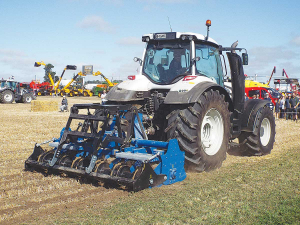Strip-till offers major savings
The Fookes family farm at Korakonui, just south-east of Te Awamutu in the Waikato.
 Tulloch Farm Machines offers the Strebel SAG 16 Strip Tillage System for establishing maize and fodder beet crops.
Tulloch Farm Machines offers the Strebel SAG 16 Strip Tillage System for establishing maize and fodder beet crops.
With farmers and contractors looking to reduce crop establishment costs, the arrival of increasingly accurate GPS and a range of specialised implements, may make 'recreational' cultivation a thing of the past.
Experts suggest that excessive cultivation is damaging soil structure, often bringing poor sub-soils up into the growing levels.
There is also the impact caused by loss of moisture and fine soils to the wind. Add to that the cost of our cultivator metal and high fuel costs, then new techniques are sure to be adopted in the coming years?
Strip Tilling is a technique that allows minimal soil disturbance, reducing cultivation costs by only cultivating a narrow band of soil where the crop is going to be established. It leaves the ground between rows unmoved and brings land back into production much more quickly.
Masterton-based importer and distributor Tulloch Farm Machines offers the Strebel SAG 16 Strip Tillage System, aimed at establishing maize and fodder beet crops throughout New Zealand.
The machine that takes the outward form of a rotary cultivator, but underneath, the traditional rotor is replaced by a unit that carries a series of "milling units" that only cultivate a band of ground where the crop is to be established.
With an overall width of 3m, the machine can be configured to prepare four rows at 75cm or six rows at 50cm spacing. Ahead of each of the rows is a subsoiler leg that can operate at depths of up to 25cm. This breaks up any plough pan, before passing soil to the rotor, which can operate to 15cm working depth for breaking down into a finer seedbed.
Rear of the milling heads, an infinitely adjustable packer system sees sectional units behind each of the four or six rotors. These reconsolidate the ground, leaving a level surface for subsequent operations. The lateral extremities of the main rotor housing feature extended side panels to create a definitive edge for the worked strips.
Manufactured using Hardox steel for durability and an extended working life, power input is 1,000rpm. It has a cam-clutch overload protection set-up, with a 4-speed main gearbox and gear-driven, lateral oil bath drive to the main rotor. Speed adjustment via the main gearbox allows operators to quickly adjust rotor speeds to ground conditions or required forward speed.
As an option, a Cat2/3 rear three-point linkage can be used to carry a precision planted. Or the installation of a front-mounted hopper can be specified to incorporate fertiliser into the prepared tillage strip ahead of the rotor.
Legal controls on the movement of fruits and vegetables are now in place in Auckland’s Mt Roskill suburb, says Biosecurity New Zealand Commissioner North Mike Inglis.
Arable growers worried that some weeds in their crops may have developed herbicide resistance can now get the suspected plants tested for free.
Fruit growers and exporters are worried following the discovery of a male Queensland fruit fly in Auckland this week.
Dairy prices have jumped in the overnight Global Dairy Trade (GDT) auction, breaking a five-month negative streak.
Alliance Group chief executive Willie Wiese is leaving the company after three years in the role.
A booklet produced in 2025 by the Rotoiti 15 trust, Department of Conservation and Scion – now part of the Bioeconomy Science Institute – aims to help people identify insect pests and diseases.

OPINION: The release of the Natural Environment Bill and Planning Bill to replace the Resource Management Act is a red-letter day…
OPINION: Federated Farmers has launched a new campaign, swapping ‘The Twelve Days of Christmas’ for ‘The Twelve Pests of Christmas’ to…